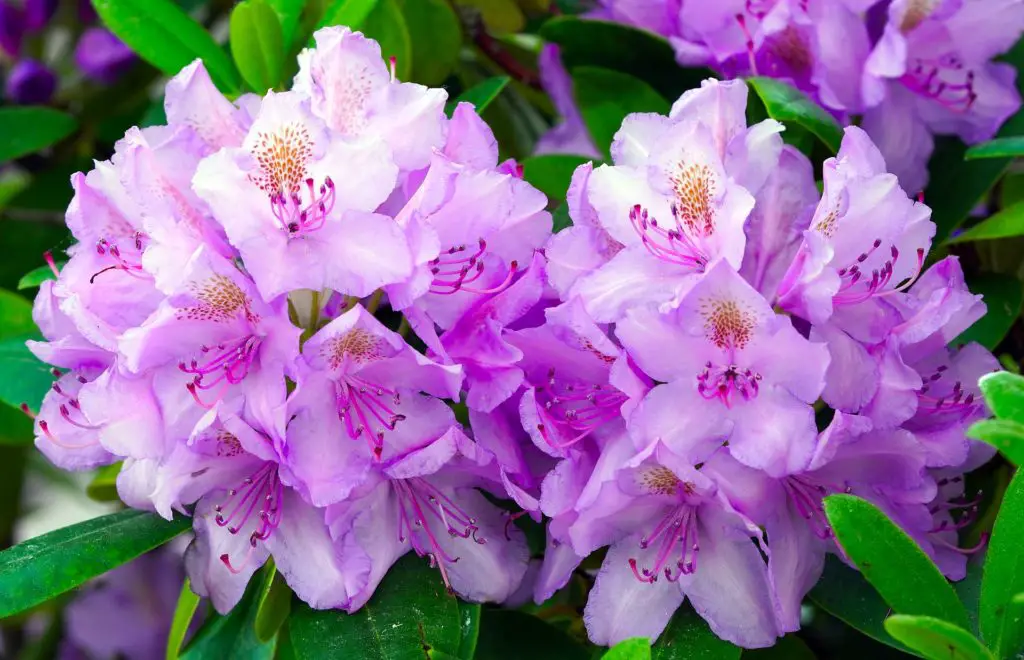I hereby profess my love to rhododendrons. All winter long, they provide lush and hearty green, with optimistic little buds giving the slightest preview of the spectacle that awaits when spring arrives. They have beautified our backyard more than any other plant and require little to no maintenance. In early spring, I noticed there was something else in my yard that had been enjoying them almost as much as me: deer. But wait, do deer eat rhododendron?
Are Rhododendron Deer Resistant?
Deer will eat rhododendron when they are hungry even though they are not a favorite choice. Since rhododendrons stay green all year, this typically happens in the winter months when there is less foliage available as a food source.
The good news is that during the spring when the rhododendrons are really showing off, the deer will generally ignore them because there is an abundance of more delicious plants to munch (like my dogwoods or hostas, which they can’t seem to get enough of!).
It’s helpful to be aware of this feeding pattern because it could determine when and how you plant your next rhododendron.

Timing Your Rhododendron Planting to Withstand Deer
If you live in area prone to lots of deer visitors, it may help to plant rhododendrons at the start of the warmer months. The deer will have plenty of other things to eat at this time and will likely not take much of an interest in your new rhododendrons. I recently had a conversation about this with an agent from the local office of my state’s Cooperative Extension System, and they explained that rhododendrons are must vulnerable when they are young and small.
Once they become established in their new soil, they will likely have no trouble tolerating an occasional chomp from deer. By planting in spring, you’ll give your rhododendrons many months to become stronger and more resilient before the deer take an interest in them.
It is important to consistently give your new rhododendrons water after you plant them, regardless of the time of year. Rhododendrons have fine roots that grow relatively close to the surface of the ground. This means that they can dry out fairly easily while they are getting settled in their new home and establishing a strong root system.
Once they are established, they don’t require much water. I only water mine during particularly hot and dry periods of the summer. Applying mulch around your rhododendrons is a good way to help maintain the soil’s moisture and get the most from your watering efforts.
Keeping the Deer Away from Rhododendron During Winter
There are an endless supply of solutions on the market to repel deer, and several DIY options. Knowing that the deer’s interest in your rhododendrons is likely seasonal during winter can help you select the best option. Here are a few methods for protecting your rhododendrons from hungry deer during winter.
Temporary Fencing
Installing a temporary fence around your rhododendrons during cold months can protect them from deer. A strong barrier is not required to deter deer for a few months. Some inexpensive options that are easy to install include chicken wire or plastic mesh attached to wooden stakes.
Repellent Sprays and Other Applications
Deer do not like fragrances so applying a deer repellent spray with a strong odor can be a deterrent. Deer repellents are sold as sprays that usually contain animal urine or plant essences. You can also make your own using garlic, hot sauce or eggs. In my experience, such sprays will work well only if you are consistently reapplying them.
Medium to heavy rains wash any of these products off (regardless of what the labels say), so you’ll need to make spraying your rhododendrons part of your yard maintenance routine. Deer repellents are also sold as “clips” that attach to the trunks or stems of your plants. The clip products tend to last a bit longer than the sprays, but have less range. Therefore, deer must get close to the plant before smelling the clip.
Deer Repelling Plants as a Natural Compliment to Your Rhododendrons
Plant a natural deer repelling plant near your rhododendrons. Aside from the commercially available products, there are several plants that emit fragrances that are pleasant for humans but not agreeable to deer. Some examples of these are lavender, garlic, mint, rosemary, or other herbs. In my experience, this method only works to deter them temporarily, and when they get hungry enough, they will return.
Lights and Ultrasonic Sound Devices
Install a motion-activated deer repeller device, which uses flashing lights and ultrasonic sounds to startle and scare deer away. The frequency of the sound makes it nearly silent to humans. You may hear the device when standing close, but neither the sound nor the flashing lights are distressing to humans.
In my experience, these devices only work well for a short period before the deer stop being startled by the sound, stop feeling threatened, and go right back to snacking on my landscaping. You will need to move the devices to different locations periodically to maintain the element of surprise.
The last time I tried them in a mulched bed with hostas, it kept the deer away for about two months. Every two weeks, I moved them to a new section of the bed. Still a motion activated device may buy you enough time to establish some new roots on your rhododendrons or other new plants.
I have personally used each of the solutions on this list. In my experience, there is one method that stands above the rest to keep the deer away from your prized plants all year long. That method is motion activated water sprinklers. Deer never seem to grow accustomed to being sprayed with water, yet the method is both gentle and safe. Since deer typically do their snacking in yards at night, many of these devices have day and night detection modes to make sure that you and your family will not get inadvertently sprayed.
